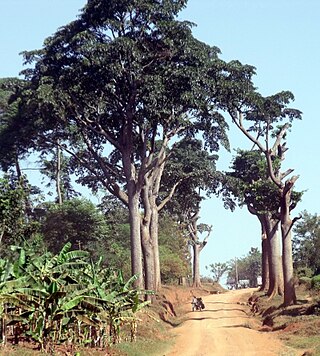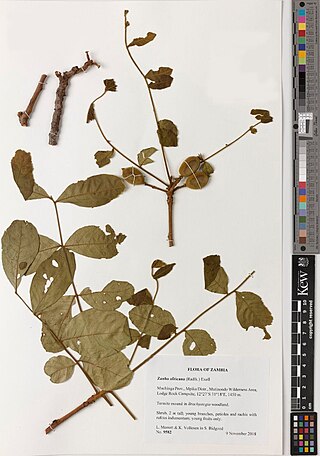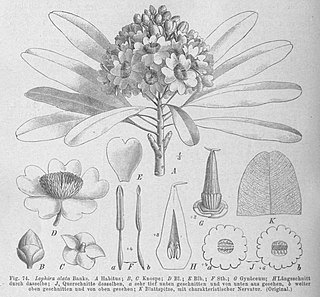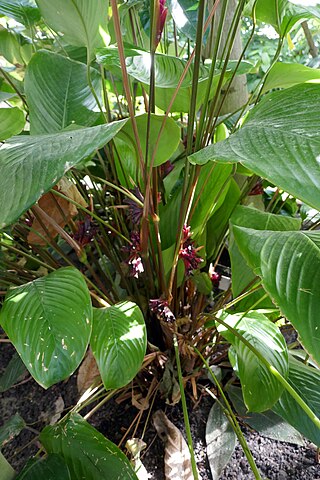
The mantled guereza, also known simply as the guereza, the eastern black-and-white colobus, or the Abyssinian black-and-white colobus, is a black-and-white colobus, a type of Old World monkey. It is native to much of west central and east Africa, including Cameroon, Equatorial Guinea, Nigeria, Ethiopia, Kenya, Tanzania, Uganda and Chad. The species consists of several subspecies that differ in appearance. It has a distinctive appearance, which is alluded to in its name; the long white fringes of hair that run along each side of its black trunk are known as a mantle. Its face is framed with white hair and it has a large white tail tuft.
Albizia ferruginea is a species of plant in the family Fabaceae. It is found in Angola, Benin, Burkina Faso, Cameroon, Central African Republic, the Republic of the Congo, the Democratic Republic of the Congo, Ivory Coast, Gabon, Gambia, Ghana, Guinea, Guinea-Bissau, Nigeria, Senegal, Sierra Leone, Togo, and Uganda. It is threatened by deforestation

Milicia excelsa is a tree species from the genus Milicia of the family Moraceae. Distributed across tropical Central Africa, it is one of two species yielding timber commonly known as ọjị, African teak, iroko, intule, kambala, moreira, mvule, odum and tule.

Zanha africana, commonly known as the velvet-fruited zanha in English and as mkalya or mkwanga in Swahili, is a species of plant in the family Sapindaceae that is native to Africa. It is used locally for timber and herbal medicine.
Erythrophleum ivorense is a species of leguminous tree in the genus Erythrophleum found in the rainforests of tropical West and Central Africa. The tree has many uses; the timber is used for heavy construction, for making charcoal and for firewood, the bark is used for tanning and in traditional medicine, and both bark and seeds are poisonous and used for hunting.

Lannea welwitschii is a species of tree in the family Anacardiaceae. It is native to the tropical rainforests of West and Central Africa. The timber is used to make furniture and utensils and for many other purposes, the fruits can be eaten, and the bark is used to produce a dye, for making rope and in traditional medicine.

Lophira lanceolata, commonly known as the dwarf red ironwood, is a species of tree in the family Ochnaceae which is native to tropical West and Central Africa. The timber is used for heavy construction, an edible oil can be extracted from the seeds and various parts of the plant are used in traditional medicine.
Daniellia oliveri is a species of tree in the family Fabaceae. It is native to tropical West and Central Africa and is commonly known as the African copaiba balsam tree, or the West African copal tree.
Drypetes gerrardii is a species of small tree or large shrub in the family Putranjivaceae. Common names include forest ironplum, bastard white ironwood, and forest ironwood. It is native to tropical and subtropical central and eastern Africa. It was first described in 1920 by the English botanist John Hutchinson, who named it after the English botanist William Tyrer Gerrard who collected plants and seeds in southern Africa in the 1860s.
Guibourtia tessmannii is a species of legume in the family Fabaceae. It is a medium to large-sized tree and is native to Cameroon, Gabon and Equatorial Guinea. The timber has an attractive appearance and has many uses, and the bark is used in traditional medicine.
Cynometra ananta is a perennial large tree within the Fabaceae family. Its timber is traded under the name Apome in Ivory Coast and Ananta in Ghana.
Anthonotha macrophylla is a shrub to small understory tree within the family Fabaceae. It is endemic to the rain forest regions of West Africa and it is the most common of species within the Anthonotha genus in Africa.

Berlinia grandiflora is a small to medium sized tree found in the West and West Central African region along riparian habitats or gallery forests habitat types.
Entandrophragma angolense, called the tiama, is a tree species with alternate, pinnately compound leaves that are clustered at the ends of branches. It is within the family Meliaceae and has a wide distribution area, occurring in moist semi-deciduous and evergreen forest regions of Tropical Africa from Sierra Leone to Uganda.
Ficus vogeliana is a species within the family Moraceae which bears flagellifom infructescences. Its outer bark tends to be greyish in color while the slash is reddish.

Ficus vallis-choudae is a shrub or small to medium sized sized tree within the family Moraceae, in the genus Ficus and sub-genus, Sycomorus.
Ochna holstii is an evergreen medium to large sized tree belonging to the family Ochnaceae.
Strombosia scheffleri is a medium-sized tree that is native to Tropical Africa, the species is sometimes planted as a shade tree in coffee and cocoa plantations. It belongs to the family Olacaceae.
Brachystegia leonensis is a medium to tall sized tree occurring in the rain forests of West Africa, belonging to the family Fabaceae. It is one of three species within the genus Brachystegia that is represented in West Africa. It is morphologically close to Brachystegia kennedyi, a species occurring in Nigeria.
Albizia glaberrima is a deciduous tree found in Tropical Africa, it belongs to the family Fabaceae. It is traded under the name 'white nongo' and it is well distributed in West, Central, East and parts of Southern Africa.







